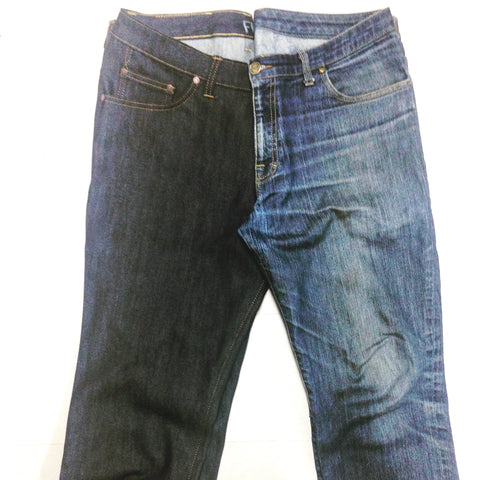Selvedge Denim Guide
This guide is a brief introduction to the world of selvedge denim, and is dedicated to the small but vibrant community that loves it.
WHAT IT IS
The term "selvedge" (or "selvage") is an adaptation of the word "self-edge" and refers to a finished edge of fabric that is woven shut. The telltale sign of selvedge jeans is the self-finished edge along a jean's side seam, which denim aficionados pop, cuff or otherwise highlight. A jeans selvedge ID is defined by the color of the ticker woven along the self-finished edge, which originally identified the mill that produced it.
14oz denim with redline selvedge ID.
HOW IT'S MADE
Most denim is sewn on projectile looms, which send a large number of picks carrying "weft" or "fill" yarns across the face of the loom to be cut and sewn shut. These modern machines are about twice the width of vintage machines and are highly efficient.
Selvedge denim, however, is woven exclusively on 1940s era shuttle looms and have a single wood pick that shuttles across the loom, left to right and back again, weaving the weft yarn into the vertical "warp" yarns. This creates a very tight weave and a continuously finished edge - or "self-edge".
Historically, all denim was selvedge denim. However, modern processes made selvedge denim less cost effective and their popularity began to wane in the 1950s. More recently, selvedge denim has made a resurgence as customers rediscover the quality and character of this time tested fabric.
FADES
Most selvedge denim comes to market as "raw" denim, which means it has not undergone any harsh chemical processes after being woven. This maintains a stronger fiber quality and ensures production is environmentally friendly.
It also means the indigo hasn't set throughout the yarn. Over time, this produces fades in areas of high friction as your body movement naturally removes the external indigo to reveal the cotton core. Fades take a number of forms, including whiskering (throughout the front top block), honeycombs (behind the knees) and roping (at the bottom of the hem).

Two jeans, one fabric, with strong whiskering throughout the top block.
Selvedge denim, with its naturally tight weave and distinct characteristics, produces the most defined and interesting fades.
CARE
To set deep fades, you'll want to wear your jeans often and resist the urge to wash them. The conventional wisdom, which I happen to agree with, is that about 180 days of wear before a wash or rinse will set the indigo and create strong fades.
After that initial period, it's OK to rinse or wash you jeans more frequently. More regular care will help extend the life of your jeans by removing bacteria that builds up in natural fibers and accelerates fabric degradation.
Always wash your jeans inside out to preserve color quality and use a color friendly detergent like Woolite Dark. While most raw denim is sanforized, a process that removes shrinkage, machine drying raw denim can still shrink the fabric meaningfully (up to 3%). (A good rule of thumb to remember is the higher the heat, the greater the shrinkage.) So to preserve the fit and size of your jeans, let them hang dry in your bathroom overnight.
Baby's first soak after 6 months of constant wear.
If, on the other hand, you'd like to preserve your jeans color and prevent indigo transfer, wash raw denim with a cup of white vinegar. To accelerate overall fading, try an ocean wash.
-
9oz and below - Lightweight
Easy breezy denim that's right for hotter climates. Can be worn during summer, but also in late spring and early fall. -
10-12oz - Classic weight
Where most jeans clock in. Solid but breathable fabric that will do you right all year round. -
13-16oz - Mid-weight
Enter structure. Will produce stronger fade characteristics than classic weight, but will take a few wears to break in. -
17oz and above - Heavyweight
Ride 'em cowboy. A labor of love that wants to be tamed. Should reward you with strong fade patterns for years to come.
TYPES
There are many different types of selvedge denim to choose from. Neppy denim pulls weft yarn through the fabric to create a "popcorn" effect; slubby denim utilizes uneven warp threads to create crosshatches and a textured hand; denim can be red, grey or green cast; and there's different fabric compositions with touches of elastane, polyester and kevlar, just to name a few.

Crosshatching (indicated by horizontal white wisps) are caused by slub.
At FITTED Underground, we have a core line of selvedge denim products that are tried and true, and will produce beautiful fades over time. We also drop more exotic selvedge styles from time to time, so definitely subscribe to our newsletter for the latest product updates.
FIN
Selvedge denim are part of that small, rarefied world of products that get better with age. Perhaps more than any other fabric, they tell your story. Which is why selvedge denim make great jeans, but it's you that makes selvedge denim great.
RESOURCES
Heddels: all things denim (and more) online
Denim definitions: from PBD, a fine source
Cone Mills and Levis: two of my inspirations
Reddit Raw Denim: an online community
Next: Adjustments and Returns
Back: FAQs



